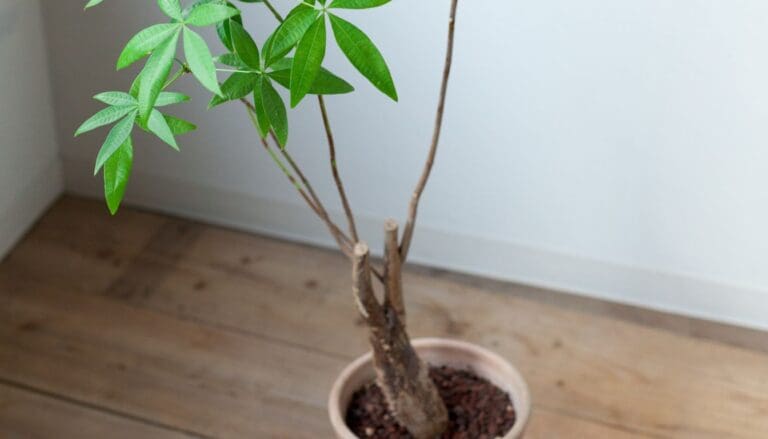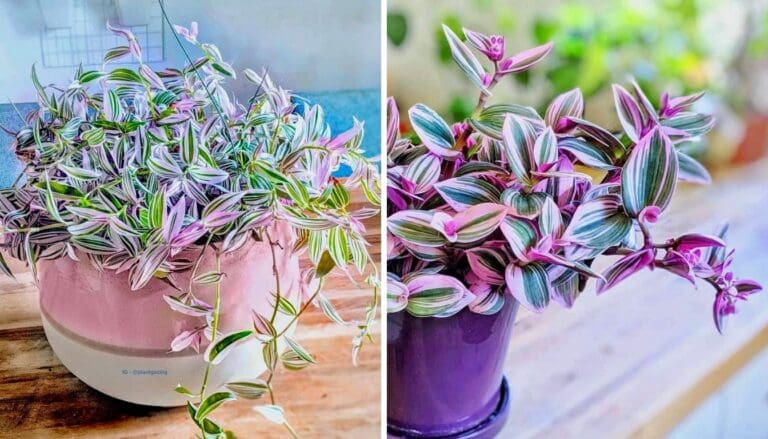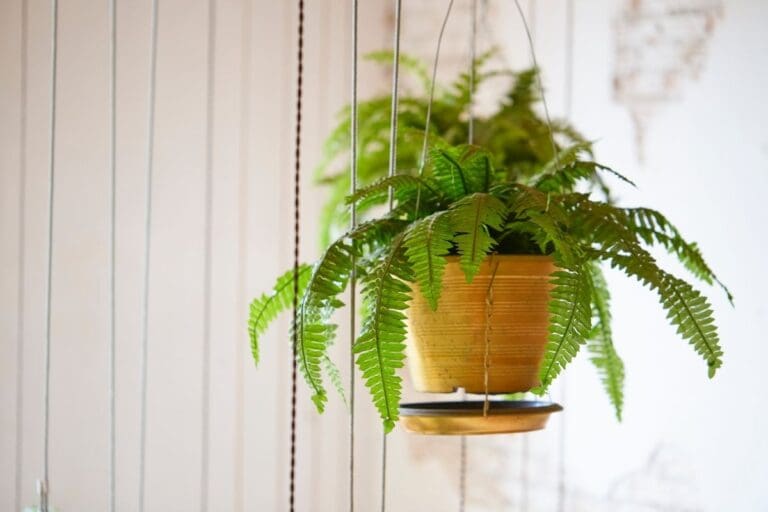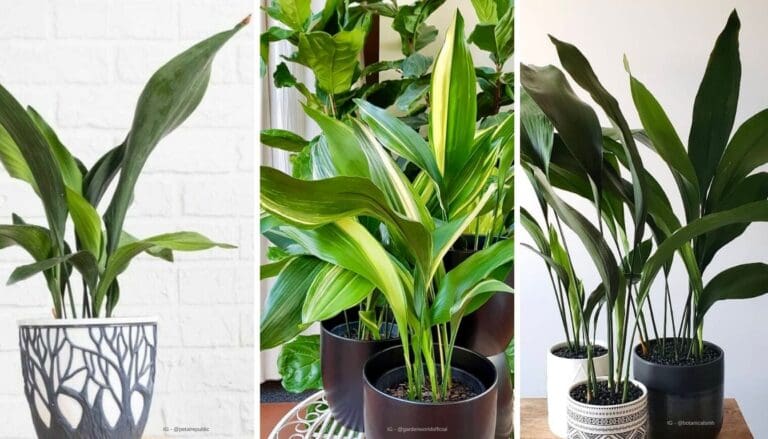6 Must-Know Tips for Fall Care Of Fiddle Leaf Fig
Taking care of a fiddle leaf fig in the fall? Yeah, it can get a little confusing.
The season messes with light, temperature, and humidity, so our leafy friends could use a bit of extra TLC.
I want to share some simple tips to help my fiddle leaf fig stay healthy and strong as the weather changes.
I know a lot of folks worry about their figs this time of year, but honestly, a few small tweaks can make a surprising difference.
Please note: Simplify Plants is reader-supported. As an Amazon Associate, I earn from qualifying purchases made by our readers with no extra cost added to you all! Some links in the post are affiliate links and I get a commission from purchases made through links in the post.
1) Reduce watering frequency as temperatures drop

When fall rolls in, I always remind myself to water my fiddle leaf fig less often.
Cooler temps mean the soil just doesn’t dry out as fast, and if I keep up my summer watering habits, those roots can end up sitting in soggy soil.
I check the top couple inches of soil every week. If it feels damp, I wait a bit longer before watering—only when it’s dry to the touch.
Overwatering during fall can cause root rot, and nobody wants that. I’ve learned my plant doesn’t need as much water when it’s not growing like crazy.
Usually, my fiddle leaf fig wants water every 10 to 14 days in fall, and I use less each time. Just enough to moisten the soil seems to do the trick.
Sunlight drops off in fall, too. Less light means slower growth, so the plant just doesn’t drink as much.
If I’m unsure, I’ll stick my finger in the soil before reaching for the watering can. Waiting a little longer between waterings really helps keep things on track.
A good rule of thumb? When in doubt, it’s better to underwater than overwater during fall.
2) Move the plant to a spot with bright, indirect light

I always try to make sure my Fiddle Leaf Fig gets plenty of bright, indirect light in the fall. Days get shorter, sunlight’s weaker, and the plant needs all the help it can get.
Direct sun can scorch the leaves if I put my plant too close to a south-facing window. I avoid that by keeping it near a window with filtered light or behind a light curtain.
If a window’s not sunny enough, I’ll move my plant to a brighter spot just for the season. East-facing windows are great for soft morning light.
I try not to move my Fiddle Leaf Fig too often, since it can stress the plant out. But when fall comes, it’s worth making sure it’s in the right spot for light.
When the leaves start reaching toward the window, I know it’s happy. If they turn yellow or look dull, I check if it needs more light.
If I’m working or hanging out near a window, I’ll plop my plant there too. We both get to soak up some rays.
Sometimes, my rooms are just too dim in fall. When that happens, I’ll use a grow light for a few hours each day, and honestly, it helps a lot.
I always keep an eye on my plant after moving it. If it’s looking sad, I’ll try a different spot until the leaves perk up again.
Keeping my Fiddle Leaf Fig in the right light isn’t rocket science—just takes a little attention. Bright, indirect light is the secret to happy leaves in fall.
3) Increase humidity with a pebble tray or humidifier

Dry air can really mess with my fiddle leaf fig, especially in fall. Once the heaters kick on, the air gets dry and my plant’s leaves can suffer.
One easy way I boost humidity is with a pebble tray. I fill a shallow tray with pebbles, add water just below the tops, and set my plant pot on top (without letting it sit in the water).
As the water evaporates, it adds a little moisture to the air right around the plant. This simple trick keeps the leaves from getting crispy edges.
Another move is a humidifier nearby. I’ll let it run for a few hours most days, especially when the air feels desert-dry.
Using a humidifier is pretty much set-it-and-forget-it. Bonus: it helps my skin, too.
I keep my plant away from heaters and vents to dodge even drier air. Keeping humidity up helps my fiddle leaf fig stay strong, even as the season shifts.
By adding a pebble tray or running a humidifier, I make sure my plant has the moisture it needs. It’s a tiny change that really pays off for healthy leaves and happy growth.
4) Trim yellowing or damaged leaves promptly

I always check my fiddle leaf fig for yellowing or damaged leaves in the fall. If I spot any, I snip them off right away—no hesitation.
Yellow or brown patches usually mean the leaf’s given up. Removing these lets the plant focus its energy on what’s still thriving.
I use clean, sharp scissors or pruning shears. Clean tools help prevent spreading disease to healthy leaves.
I make my cuts close to the main stem, but I’m careful not to nick it. When I get rid of damaged leaves, the plant has more energy for healthy growth.
Trimming regularly also helps improve airflow around the leaves. That’s one less thing for mold or pests to latch onto.
I give my fiddle leaf fig a quick check once a week in the fall. Staying on top of damaged leaves helps it focus on healthy growth and gets it ready for winter.
5) Avoid sudden temperature changes near drafts

I always keep my fiddle leaf fig away from drafty windows and doors, especially once fall hits. Cold drafts or sudden blasts of warm air can shock my plant. That can lead to leaf drop or weird brown spots.
If I feel a cool breeze near my fig, that’s a warning sign. I check for air vents, open windows, or doors that might let in cold air.
Even a heater blowing hot air right on the plant isn’t great. I try to find a spot with consistent temperatures—no wild swings.
If I notice a drafty spot, I move my plant to a safer area. This really helps keep the leaves healthy and green.
I aim for room temps between 65°F and 75°F. Big swings outside that range make my fiddle leaf fig struggle.
If it gets chilly at night, I close windows early to keep things steady. During fall, the weather outside changes a lot, but I try to keep things cozy for my plant.
6) Check for pests like spider mites regularly

I’m always on the lookout for pests in the fall. Spider mites are tiny but can be a real headache for my fiddle leaf fig.
These little guys love dry air, which is way more common in the cooler months. I check under the leaves for fine webbing or tiny moving dots.
If I see yellow or brown specks, that’s another clue. I use a soft, damp cloth to gently clean the leaves every week—makes it easier to spot bugs early.
Regular cleaning keeps dust off, too, so the plant can breathe. When I water my plant, I check the soil and lower leaves for sneaky pests.
Sometimes I use a magnifying glass if I’m not sure what I’m seeing. If I spot spider mites, I rinse the leaves with lukewarm water.
Sometimes I’ll spray a mix of water and a drop of mild dish soap, but I always test it on a small spot first. Harsh chemicals? Nope, not for me.
To keep spider mites away, I’ll mist my plant with water to increase humidity. Spider mites hate moisture, so a little misting helps.
I make sure my plant isn’t sitting near heaters or vents—dry air just makes pest problems worse. Checking my plant often lets me catch any issues before they get out of hand.
This way, I keep my fiddle leaf fig healthy and looking great all season.
Understanding Fiddle Leaf Fig Needs in Fall
In fall, my fiddle leaf fig faces changes in daylight and temperature. I need to pay close attention to how these shifts affect its growth and health.
How Seasonal Changes Affect Growth
When the days get shorter and cooler, my fiddle leaf fig starts to slow down. It doesn’t grow as quickly as it did in spring or summer.
I notice it usually needs less water because the soil stays damp longer.
Key fall changes:
- Less sunlight: I often move my plant closer to a window to give it enough light.
- Cooler air: I keep it away from drafty spots or heating vents to avoid stress.
- Slower growth: I hold off on using fertilizer since the plant isn’t making new leaves.
Identifying Common Fall Issues
During fall, my fiddle leaf fig can face problems like yellowing leaves, brown spots, and dropping leaves. These issues often happen because of too much or too little water, or from unstable temperatures.
Common fall problems and solutions:
| Issue | Cause | What I Do |
|---|---|---|
| Yellow leaves | Overwatering | Check soil before watering |
| Brown spots | Drafts or cold air | Keep plant in steady warmth |
| Leaf drop | Sudden light changes | Move slowly to brighter spot |
By watching for these signs, I know when to fix problems quickly and keep my fiddle leaf fig looking its best.
Adjusting Watering and Lighting
I notice my fiddle leaf fig’s needs change as fall arrives. Shorter days and cooler air mean I have to tweak my routine to keep my plant healthy and happy.
Watering Adjustments for Cooler Months
When fall rolls in, I start cutting back on watering. My fiddle leaf fig just doesn’t seem as thirsty with the cooler temps.
I always poke my finger into the top two inches of soil. If it feels dry, I’ll water—otherwise, I usually wait a few days.
Too much water in fall can lead to root rot, so I’m careful. I never let water sit in the saucer, and I make sure the pot drains well.
I use less water than I do in the summer. Cold soil just hangs onto moisture, which means overwatering is way easier than you’d think.
Quick Tips:
- Water only when top 2 inches of soil are dry
- Use room temperature water
- Avoid letting the pot sit in water
Providing The Right Light Indoors
With fall, the sunlight is weaker and days seem to vanish faster. I end up moving my fiddle leaf fig closer to the brightest window—usually south or east-facing.
Direct morning light is good, but I try to keep it out of harsh afternoon sun. If the room feels gloomy, I’ll grab a small grow light to help out.
Every couple of weeks, I rotate the pot so the leaves don’t grow all lopsided. If my plant starts looking leggy or the leaves fade, it’s probably begging for more light.
My lighting checklist:
- Place near a sunny window
- Rotate pot for even growth
- Use a grow light if needed
- Keep leaves dust-free for better light absorption
Frequently Asked Questions
I want my fiddle leaf fig to stay happy, even when the weather cools down. Watering, lighting, and humidity all shift as fall shows up.
How often should I water my fiddle leaf fig in the autumn?
I water less often once fall hits. The soil just stays wet longer because it’s cooler and the plant isn’t really in growth mode.
I wait until the top inch of soil feels dry before watering again. No strict schedule here—just a finger test.
What’s the best way to adjust fiddle leaf fig lighting as the days get shorter?
I move the plant closer to a bright window, but I avoid harsh direct sun. Bright, indirect light keeps the leaves healthy when daylight is scarce.
Sometimes I turn the pot every week so all sides get a bit of light. It helps keep things even.
Can I still prune my fiddle leaf fig during the fall season, and if so, how?
I only prune if I spot yellow or damaged leaves. Clean scissors, snip close to the stem, and that’s it.
Heavy pruning? I skip it in fall since the plant isn’t exactly bursting with new growth.
What should I do if I notice brown spots on my fiddle leaf fig leaves during fall?
If I see brown spots, I check for overwatering or maybe drafts. I let the soil dry out a bit and move the plant away from cold or hot air.
Removing the affected leaves usually helps keep things on track.
Is it necessary to fertilize a fiddle leaf fig in the fall, and which type should I use?
I don’t bother with fertilizer in the fall, honestly. If the leaves look pale, I’ll use a diluted, balanced liquid fertilizer just once a month, but only if it really seems needed.
How can I protect my outdoor fiddle leaf fig from the cooler temperatures of fall?
When my fiddle leaf fig is outside and the nights start dipping below 60°F (16°C), I usually bring it indoors. Sometimes, though, bringing it in just isn’t practical.
On those nights, I’ll toss a sheet over it for a bit of extra warmth. I try to keep it away from chilly drafts, too—those can be sneaky.
Honestly, humidity trays have been a lifesaver. They help stop the leaves from drying out, which can be a real pain as the air gets cooler.
Note: Some images in the articles are sourced from Reddit and Other Platforms For Reference Purpose.





